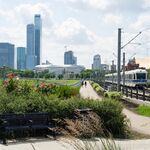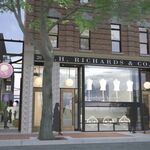-------------------------------------------------------------------------------------------------------------------------
At this point in the video, my opinions on how ETS should expand the LRT really diverge from yours. In the spirit of constructive dialogue, I want to explain why I don't see eye-to-eye with you.
High-Floor Network Expansion:
9. Branching on the high-floor lines: I'm not a fan. Train frequency in the interlined downtown tunnel is hard-capped to 2.5 minutes. Hence, the Metro and Capital Lines can individually achieve 5-minute frequencies max. Good enough. However, adding branches to the lines makes the frequency on each branch max out at 10 minutes, which is excruciatingly low, and that's assuming we run on peak-hour frequencies. Pre-pandemic, when the Metro Line still had signalling issues, the northeast leg of the Capital Line ran on a 5-5-10 frequency, and commuters, who were predominantly coming from Clareview, HATED it. And in my experience using the south leg of the Capital Line from Century Park, I hate when the frequencies go below 1 train every five minutes. If we want to entice suburbanites to ditch their cars by making transit more convenient, the frequencies have to be at least 1 train/5 minutes. You said it yourself that the LRT needs to embrace a subway mentality of higher frequency, and I agree. The high-floor LRT should be metro-esque, not an S-bahn with low-frequency branches. The latter will be redundant anyway, since the province wants to invest in regional rail.
10. Your Metro Line branch: I don't think Castle Downs Road/167th Ave is a good route for LRT. It's a sea of single-family homes with no trip-generators nor clusters of high-density (McConachie Plaza being the one exception), and virtually none of the residential and commercial development faces the main road. Plus, there's a big wetland and cemetery standing in the way to Gorman.
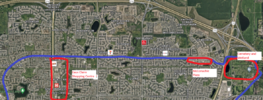
I haven't considered the idea of a northside crosstown LRT before (BRT, yes), but if there's anywhere to put it, it should be 137th Ave. It's still fairly low-density but there are a lot more major shopping centers (mostly malls and strip malls) that act as decent trip generators. Plus, the residential and commercial development mostly faces the road, making the alignment more amenable to higher-density infill creeping in over time.

I'd take it one step further and extend this route along St. Albert Trail to Westmount, Telus World of Science and West Edmonton Mall. Take your pick of whether this crosstown line should be high-floor (hence separate alignment to WEM) or low-floor (partial interlining with Valley Line to WEM)
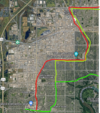
11. Your branch to Sherwood Park: yeah... it's not great. I understand that getting the LRT across Refinery Row poses a major challenge for where to put it, but there are better alternative routes south of the river. Your route poorly serves the neighbourhoods along the Yellowhead within Edmonton city limits. To the north of your routing is the freeway, some industrial areas, the CN Rail ROW and then low-density suburbs - all-in-all, low ridership potential. South of the Yellowhead is Beverly, which is an older neighbourhood ripe for infill, especially along its main street, and already has lots of high-density development on its eastern end (Abbottsfield, which also has a shopping centre). It's prime real estate for the LRT, but by routing it along Yellowhead Trail, it's almost completely separated from the high-density residential, commercial and infill development deeper in the core of the neighbourhood. A stop along the Yellowhead Trail would be so out of the way, that there isn't a point in building any stop on this branch within Edmonton city limits.
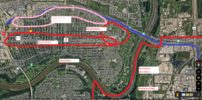
And that brings us to the crux of the problem: your route is only useful to Sherwood Park residents. That means Edmonton won't bother to contribute to its construction, but Strathcona County would only want to pay for the portion of the line within its jurisdiction, so this'll never get built. A better alternative would be a subway down Beverly Main Street I guess, but I can't justify the cost of that, and again, it branches off the Capital Line and sacrifices frequency to both Clareview and Sherwood Park, making no one happy. I'll suggest a better alternative later.
12. Urban-style LRT in the suburbs: interesting point to raise, but I have counterpoints. For one, Sherwood Park and St. Albert are massive, and many trips will take place entirely within these communities. Even out in these suburbs, the LRT should still be fast and segregated, or else people will still opt for their car for journeys within town, and if they decide to travel into Edmonton, they'll be more likely to drive to a park'n'ride instead of hopping on the train at their local stop. Plus, they funnel their traffic into a few wide arterial roads that should be grade-separated.
13. Train to Fort Sask: this would be dope. That whole swath of land between Manning Drive and the river is slated for suburban development, and the LRT will incrementally make its way towards Fort Sask as a two-track alignment. But a regional rail route on the CN Rail ROW would be fantastic in the interim!
14. Rapidbus routes as precursors to LRT is a smart idea. We were on the cusp of this, but budget restrictions said otherwise.

Hopefully, once the coffers have a bit more money, we can bring this back.
15. LRT to YEG: I would die of happiness if this happened. My only criticism is how you draw the route. The farmland between 41st Ave SW and the Airport is also slated for suburban residential and industrial use (it is what it is...), and it makes more sense to run the Capital Line through these neighbourhoods rather than along the highway, since a lot of airport employees will probably live in these new suburbs, and the LRT should act as more of a local service connecting them to their jobs. High-speed rail and regional rail can alongside the QE2 instead, filling the niche of express service from the airport to the core. I also appreciate that routed the LRT to link directly to the terminal, which is something that the airport masterplan has unfortunately dismissed. The Leduc connection is also good, since a lot of YEG employees live there too.
16. Metro Line to Windermere: although it's not what I have in mind for extending the Metro Line past Health Sciences, I will concede that it's still a fantastic idea, and many forum posters love to advocate for this line. I live near Terwillegar Drive, so I'm quite familiar with this area and can tell you that it would be well-served by high-floor LRT. Terwillegar Drive, which acts as a spine through this area, will be a freeway one day, and a centre-running LRT would be fast and fully grade-separated (think NW CTrain in Crowchild Trail median). Fort Edmonton Park and The Currents shopping centre are great trip generators, but moreover, many of the residents here commute to downtown and the university especially. You make a good point about the creek and river isolating this area, and I often witness first-hand how they bottleneck traffic. Plop down a few park'n'rides, and this line would have decent ridership.
-------------------------------------------------------------------------------------------------------------------------
Low-Floor Network Expansion:
17. Branch to Tamarack: you know how I feel about branching, but alright, maybe this would be okay. Or leave it up to the Whitemud Drive BRT route you suggest later in the video to service this area (Tamarack to Meadows to Davies to Southgate to WEM)
18. Low-floor LRT on Whyte Ave: There are some major issues with the route you drew. Knowing your opinions on putting low-floor LRT in tunnels, I presume you plan on running the LRT mostly at street-level on Whyte Ave, except at HSJ (I need you to clarify this though). However, this is a TERRIBLE idea. There are pedestrians everywhere (often drunk on weekend nights), who cause huge traffic jams. Hence, surface LRT would be slow, unreliable, and frankly, quite dangerous. The other main issue is that it isn't a one-seat ride from university. The bus routes running along Whyte Ave to/from University Station are some of the busiest in the city because many students use them to commute between home to classes, and those living and studying on campus also go to Whyte for entertainment. We should be maximizing convenience by mitigating the need for a one-stop transfer at HSJ.
So, we need a one-seat ride from University Station, and full grade separation (tunneled ofc - elevated track would never be accepted) along Whyte Ave. But why put 80-meter low-floor trains in a tunnel when you could put 120-meter high-floor trains instead to maximize the capacity of such expensive infrastructure? And remember when I said I had another idea in mind for a route to Sherwood Park, and I didn't quite agree with extending the Metro Line to Windermere? Well, what are your thoughts on this? A one-seat ride from University via the high-floor Metro Line that makes good use of a tunnel on Whyte Ave and serves Sherwood Park, while providing good service within Edmonton along the way.
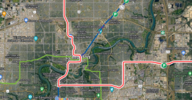

19. Low-floor route from university area to WEM: oh boy... Reece, I don't think you realize just how notorious those NIMBYs in Laurier Heights and Parkview are. Before extending the Capital Line to Century Park, Edmonton considered building it out to WEM instead, but those NIMBYs were the reason why that never happened. And now that the Valley Line West is coming, I don't think they'll ever let up. While I'd love a more direct connection between University and WEM by rail, some dreams are meant to die... That's alright. BRT in dedicated lanes on Whitemud Drive, Fox Drive, Belgravia Road and 114th Street would mostly fill this void.
